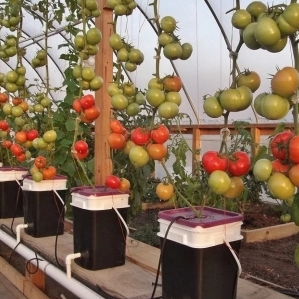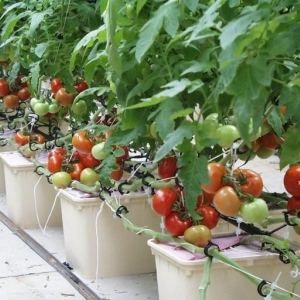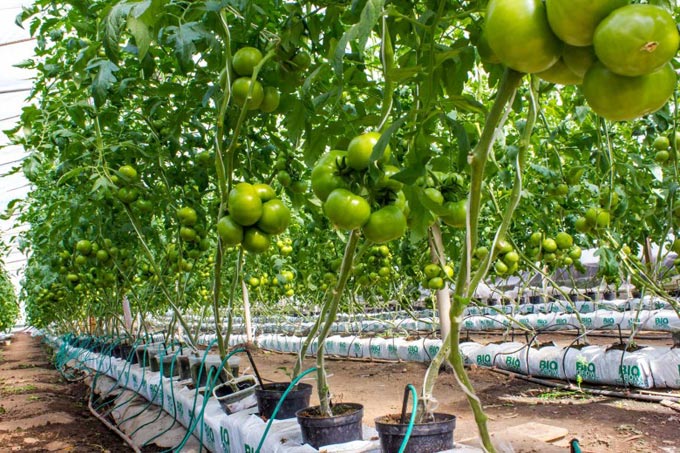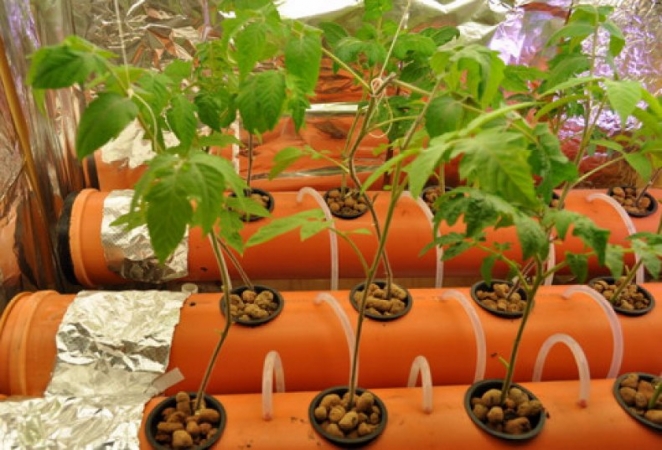Secrets of growing tomatoes at home in hydroponics
Vegetables plucked from the garden cannot be compared to those sold in stores. But what if there is a desire to grow plants, but there is no vegetable garden or summer cottage? The hydroponic method will come to the rescue. With hydroponics, you can grow tomatoes, cucumbers and other vegetables at home.
In this article, you will learn everything a novice gardener needs to know: how to grow plants in hydroponics, which solution to choose, what temperature to set, and how to assemble the system yourself.
The content of the article
What is hydroponics
Hydroponics is a technology that allows you to grow vegetables without using soil. The roots are fed with special mixtures and solutions. With this method, plants need to often to water and feed.
Hydroponics is also used for growing tomatoes. These vegetables are unpretentious, so you can harvest tomatoes all year round. The technology makes it possible to grow plants both at industrial enterprises and at home. Even novice gardeners can master the method.
Method advantage
 Economy is the main plus of hydroponics. No need to water feed plant and carry out weeding. Space is used optimally.
Economy is the main plus of hydroponics. No need to water feed plant and carry out weeding. Space is used optimally.
Also the benefits include:
- assimilation of all nutrients by the plant;
- fast growth;
- control over the growth of culture;
- high productivity;
- environmentally friendly fruits.
Disadvantages of hydroponics
The disadvantages of this method include the cost of purchasing equipment and materials. Not all gardeners will be able to establish hydroponic growing at home, so it is important to study the growing technology first.
The growing method does not protect plants from diseases and pests. And an incorrectly selected solution can damage the roots, cause flowers to fall and deformation of the fruit.
Tomato varieties for hydroponics
Experts say almost all tomato varieties can be grown hydroponically. However, experienced gardeners, through trial and error, found out that greenhouse and early maturing types of tomatoes are suitable for this system.
- Bon Appetis - a variety resistant to diseases. A garter will be needed during growth. Fruit weight - 80-100 grams, 5 kg of tomatoes can be harvested from one bush.
- Alaska- ripens in 55-70 days. The yield per plant is 3-3.5 kg of tomatoes.
- Friend F1 - resistant to diseases, begins to bear fruit in 55-70 days. One plant can collect 3.5-4 kg of fruit.
- Gavroche- grown without pinching and garter, resistant to late blight. Ripening takes 45-60 days, the weight of one fruit is about 50 g.
- Cherry tomatoes: Super Cherry and Superior Labrador varieties.
What is required for growing tomatoes in hydroponics
Successful hydroponic cultivation requires a substrate, pots of different sizes, a conductivity indicator, and a hydroponic system.
The substrate is washed and disinfected before use. It can be fine gravel and crushed stone, slag, moss, expanded clay, mineral wool, coconut, coarse sand.
For hydroponics, it is best to use pots measuring 10-12 cm. A liquid level indicator is installed on them. The pots are filled with substrate and then placed in large containers of solution. For one plant, 10 liters of substrate is enough.
A conductivity indicator is needed to determine the concentration of the nutrient solution.

Hydroponic systems come in two flavors:
- active- pumps are used;
- passive- no mechanics.
The system can have drip irrigation, nutrient bed technique or intermittent flooding. If it does not have a pump for watering the roots, an aquarium pump will do.
How tomatoes are grown
In late spring and early summer, tomato seeds are sown for seedlings. In winter, lighting costs will increase.
When sowing seeds, follow the step-by-step instructions:
- Soak seeds for 15 minutes in 1% solution potassium permanganate.
- Rinse them thoroughly.
- Place the seeds in special plugs or sponges and cotton wool soaked in a nutrient mixture.
- Water once every 2-3 days.
- After a week, place the seedlings on one side.
- After another week, transplant into special cubes.
- After 3 weeks, the well-moistened cubes are placed in a disinfected tray.
- Plants are ready to be transplanted into a hydroponic system.
Attention! One seedling requires 0.9-1.2 m² of area.
Temperature
The temperature on sunny days should not exceed +24 ° C, otherwise the flowers will fall off. An exception is the period of fruit ripening - an increase in indicators by 4 ° C is allowed.
It is important to ensure that the temperature does not drop below +16 ° C at night, otherwise the roots of the plant are preserved, which negatively affects growth and yield. The substrate temperature should be +20 ° C.
Root system control
To get good harvest, it is important to control the growth of plant roots. To do this, periodically take out small pots from the solution. As soon as the roots are visible from the hole in the container, it is necessary to reduce the amount of nutrient fluid until an air layer of 4-8 cm is formed.
Shine
Tomatoes need good lighting. If it is difficult to provide, fluorescent or ultraviolet lamps will come to the rescue. The use of only red lamps will sterilize the flowers, while the combination of blue and red helps to increase ovary and fruit growth.
Tomatoes need 20 hours of intense light during growth, and up to 17 hours during fruit ripening.
Solutions for hydroponics
Special solutions for hydroponic systems can be purchased in stores or made independently - for this, complex fertilizers are dissolved in water. However, it must be remembered that an improperly prepared solution can cause the death of the plant. Too concentrated will burn the roots, and a weak one will not increase the yield of the plant.
Different stages of plant development require a different solution composition. An important condition is that the acidity should not be higher than 6.0-6.3 pH. Potassium hydroxide will help acidify the solution, and you can reduce it with phosphoric acid.
The concentration of the nutrient solution should be checked every day with a conductivity indicator. Normal values are 1.5-3.0 mS. As soon as the limits of the norms are reached, the solution is completely changed or nutrients are added to it.
Attention! The nutrient solution is changed every 3-4 weeks.
Garter tomatoes and care
Some varieties of tomatoes need a garter. This procedure is performed as soon as the stem of the plant has grown to 20 cm. This rule also applies to low-growing varieties.
The technology provides for pollination of plants. The procedure is carried out with a soft brush, transferring pollen from one flower to another. For the plant to grow upward, the side branches must be cut off.
Hydroponic tomato growing methods
The technology of growing tomatoes in hydroponics is based on three methods: air (aeroponics), water and substrate (nutrient layer method).
Air method
The plant is fixed with clamps so that the roots are 1/3 in the substrate. The part of the roots remaining in the area of the air cushion is regularly moistened with a nutrient solution.You can retrofit a household humidifier to make spraying easier.
Water system
A foam tray is used, which is placed in a large container filled with water. Small holes are made along its entire surface for plant stems. Once they are placed in the pallet, the stems must be secured.
A compressor can be placed in a water tank to oxygenate the plants. It is undesirable to use this system for tomatoes due to high humidity.

Substrate
The root system of a plant is in a substrate environment. It can be moss or gravel. The roots are periodically immersed in a nutrient solution. The excess liquid is drained to avoid root rot. The method is not much different from growing vegetables in a greenhouse or in a vegetable garden.
How to make a system yourself
Tomato hydroponics system includes pumps, systems for irrigation and oxygen supply, containers in which plants grow, a compressor with a timer to irrigate the top of the soil.
To collect the system you will need:
- sewer pipe 140 cm, diameter - 10 cm;
- plugs - 2 pcs.;
- pipe connector;
- pots with a diameter of 10 cm;
- aquarium compressor;
- air diffuser - 2 pcs .;
- timer;
- connecting tubes.

Holes for pots are made in the pipe, a plug is installed on one side, and a connection with a plug for the compressor is installed on the other. Linear nozzles are installed inside the pipe, which are connected through hoses to the compressor. The system is filled with water, pots are installed in it.
Conclusion
Hydroponics is very convenient in big cities. Residents of the metropolis can grow tomatoes, cucumbers and other crops at home all year round. The advantages of this plant growing method outweigh the disadvantages.
In addition, you can save a lot if you assemble this system yourself from simple components. As a result, the whole family will be able to enjoy large ripe tomatoes grown on the balcony or windowsill.